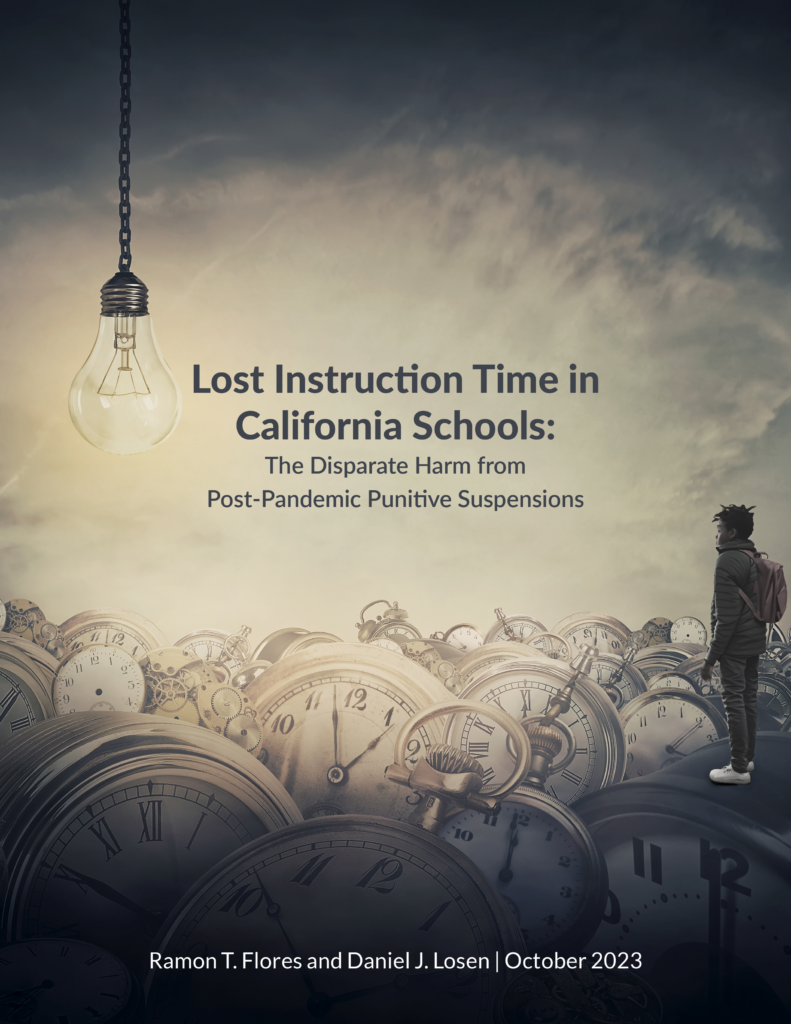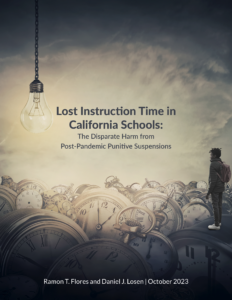Introduction
What we don’t know about school discipline and discipline disparities may be hurting the very students who most need a stable school life. The consequences of a suspension can be grave for any child, but the potential for causing extreme harm to foster and homeless youth is rarely considered by educators who punish these children by removing them from school. The uncertain living circumstances for these children are further destabilized when educators deny them access to school for breaking a school rule. The data on lost instruction due to out-of-school suspensions (OSSs) show that students with precarious living situations—foster and homeless youth of all racial/ ethnic groups—are punished far more than most other groups. This report provides a detailed review of how suspensions directly contribute to disparities in learning opportunities for students in these two groups, and along the lines of race and disability in every California school district.
While the statewide trends and disparities suggest that the rate of lost instruction in California due to OSS is about where it was before the COVID-19 school closures, this is the first report to highlight how post-COVID suspensions in 2021–2022 have added to the pandemic’s harmful impact of instructional loss, especially for students from “high-needs” groups, who were most harmed by the pandemic.1 In addition, our analysis of district-level data will demonstrate that many districts have bucked the overarching statewide trend showing a slight reduction in rates of lost instruction due to OSS in comparison to the pre-COVID years. The report also describes evidence of extreme differences in how some districts responded to student misconduct in 2021–2022. This report uses the data on student enrollment and the raw count of days lost due to OSS to establish a baseline measure for calculating comparable rates of lost instruction for every group in every district in California.
This report leaves nothing to the imagination when it comes to the disparate impact OSSs have on each group’s opportunity to learn. However, we remind readers that students also lose instruction when they are transferred to disciplinary alternative schools, suspended in school, arrested, or removed from school in ways not captured by OSS. These data also do not reflect expulsions. Therefore, although this report does not represent the total degree of harm caused by disciplinary exclusion, it does provide critically important information. The rates described in this report could be created and then reviewed by the California Department of Education (CDE), as we have used publicly available raw data collected by the CDE to establish rates of lost instruction. Unfortunately, these rates are not currently published or reviewed by the CDE or school districts when they assess school climate.
We hope these findings will resonate with parents and educators more now than before the pandemic, since the COVID-19 school closures forced all of us to share the experience of losing in-person instructional time. Furthermore, even those who are reluctant to eliminate the use of suspensions can control the length of the suspensions they mete out. We hope that all educators will reflect on their practices and ask themselves how they educationally justify each day they deny a student access to school. What is the purpose of such punishment?
Finally, the data in this report raise questions about the utility of escalating punishments for minor misconduct. When a one-day suspension did not deter a student’s further misconduct, why do educators think that suspending them for three days for repeated misconduct will do so? We hope that the readers of this report will understand that educators can and should do more to reduce the impact of punishment on instructional time.
An update to this report was published on January 8, 2024 and can be found here.
In compliance with the UC Open Access Policy, this report has been made available on: eScholarship:http://escholarship.org/uc/item/7td9r8gq

